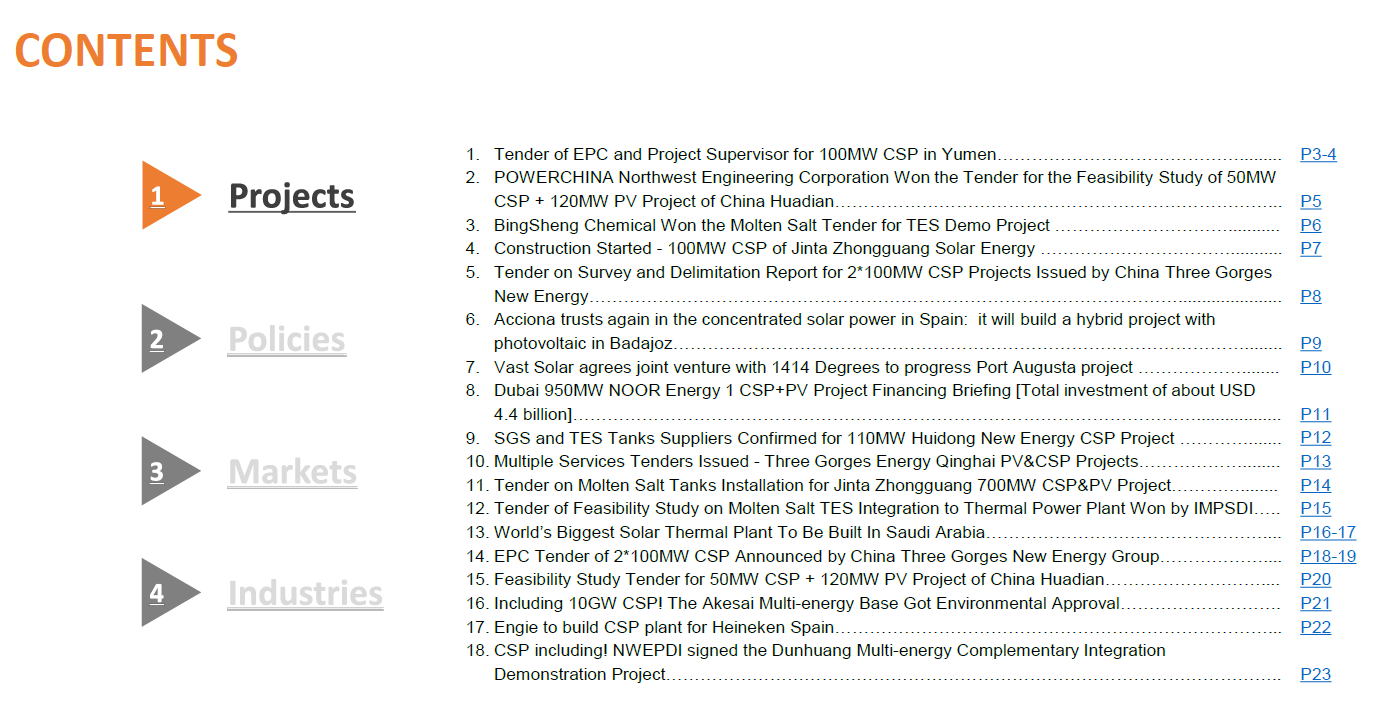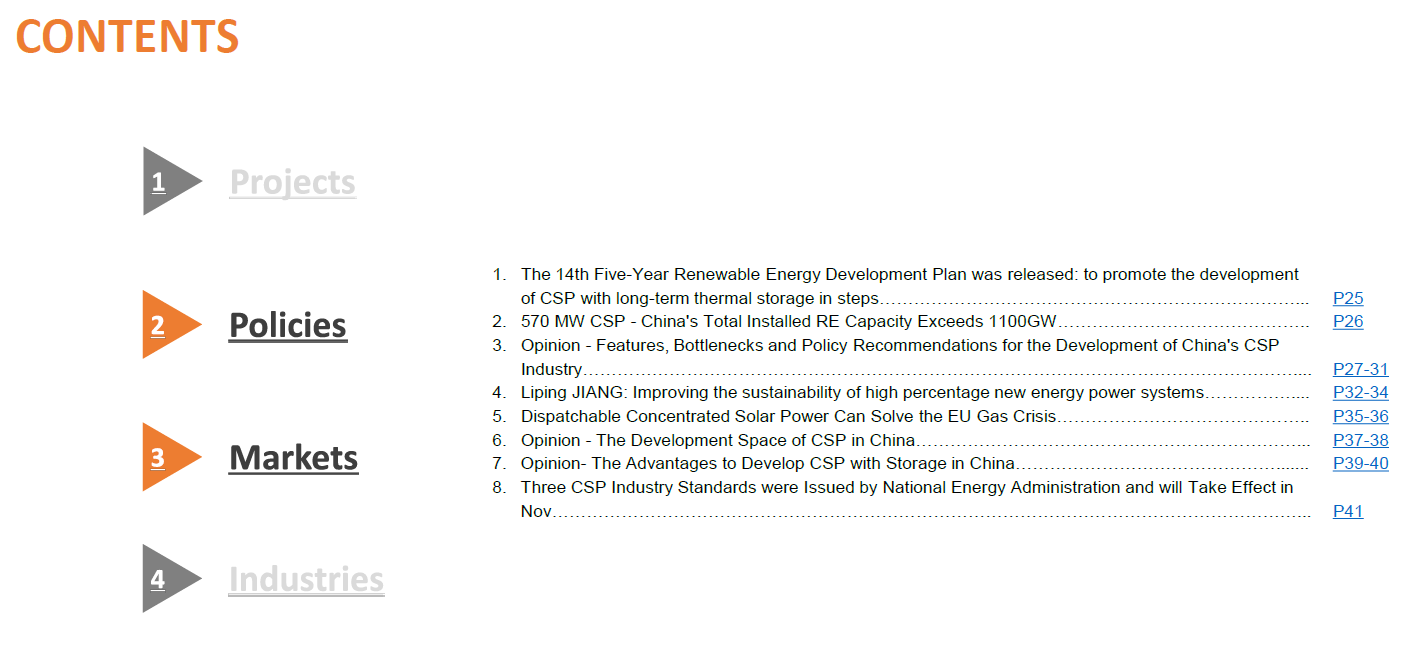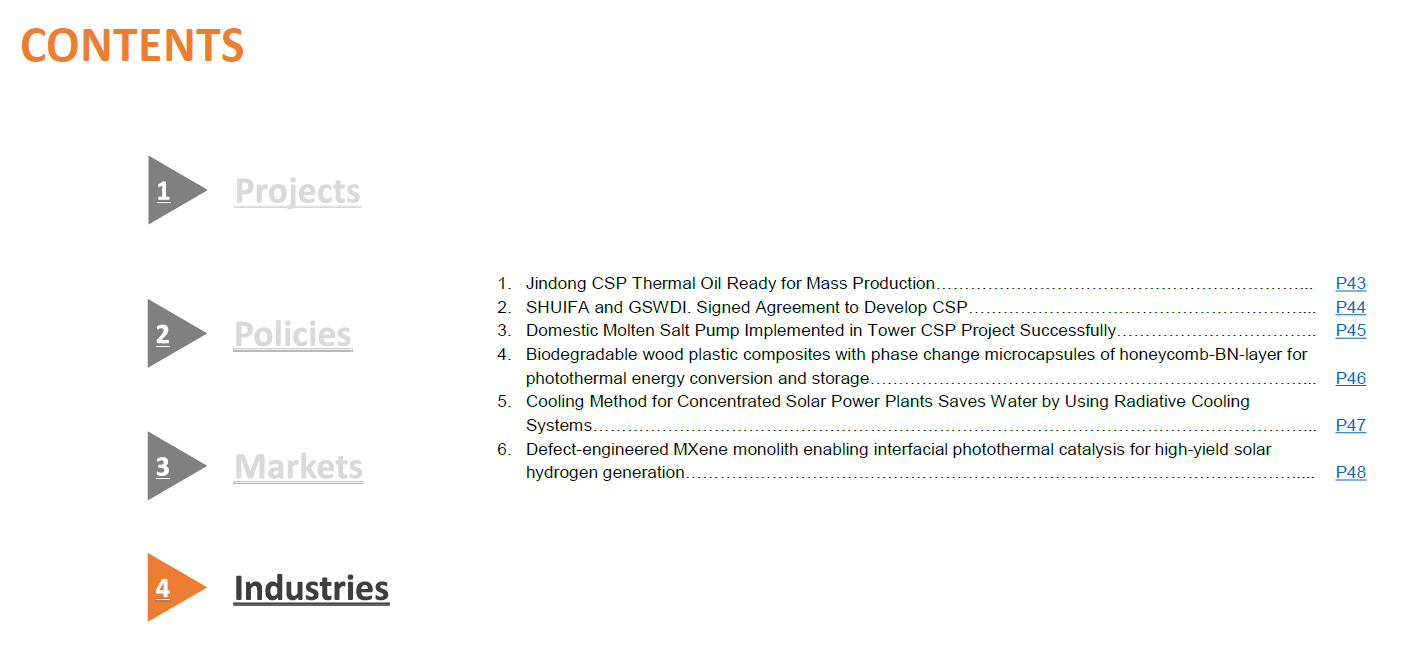Opinion - The Development Space of CSP in China
2022.07.12 From: Cosin Solar
Recently, the country released two major policies on energy development, which involve CSP in many places, reflecting the important role of CSP in the future energy system.
On May 30, the General Office of the State Council released "On the Promotion of a New Era of High-quality Development of New Energy Implementation Plan", drafted by the National Development and Reform Commission and the National Energy Administration. The plan requires to optimize the peak and frequency power compensation mechanism, increase the flexibility transformation of coal power plant, expand hydropower capacity, promote the development of pumped storage and solar thermal power generation project and the rapid development of new energy storage. Encourage the use of solar thermal power generation as a peaking power source in the west and other areas with good solar conditions.
On June 1, nine Ministries and Commissions jointly issued the "14th Five-Year Plan" Renewable Energy Plan. The plan points out that, to enhance the storage capacity of renewable energy, will orderly promote the development of CSP with long-time thermal storage. Promote the key core technology research and development, to reduce CSP cost significantly. In Qinghai, Gansu, Xinjiang, Inner Mongolia, Jilin and other areas of high quality solar resources, the construction of CSP with long-term thermal storage projects may bring to the grid regulation capacity and system support capabilities. To promote the integrated development and operation of Wind, PV and CSP, and enhance the stability and reliability of new energy generation.
Solar Resources
The abundance of solar energy resources is the primary basis for siting solar thermal power plants. So how to evaluate solar resources, we first need to understand a few concepts.
The solar radiation reaching the ground is called total radiation and consists of two components, namely "direct radiation" and "scattered radiation".
- Direct radiation: the sun is projected directly onto the ground in the form of parallel light. On the part of the radiant energy.
- Scattered radiation: solar radiation is scattered by the atmosphere, down to the ground part of the radiant energy.
Photovoltaic panels
Absorb direct and scattered radiation, so the solar resource of a PV plant is evaluated by the total horizontal radiation (GHI, Global Horizontal lrrdiancne ).
Heliostat
Direct solar radiation is reflected and collected on the surface of the absorber to obtain heat, so the solar resource of a solar thermal power plant is evaluated by normal direct irradiance (DNI, Direct Normal lrradiance) data.

The DNI value of the project site is an important factor affecting the power generation and the cost of electricity for the solar thermal power plant. Therefore, in the site selection stage of the solar thermal power plant, the first step is to collect the solar resource data as the basis for analysis and to select the site with a higher annual DNI. According to the "Notice on the Organization of Solar Thermal Power Demonstration Projects" issued by the National Energy Administration, the DNI value of the construction site should not be lower than 1600kWh/m in order to ensure a good economy of the solar thermal project.
China's solar radiation resources are widely distributed, and the areas suitable for the construction of solar thermal power plants are mainly concentrated in the western and northern regions, mainly in Tibet (DNI about 2400~2700kWh/m), Qinghai (1900~2100kWh/m), Gansu (1700~2100kWh/m), Xinjiang, Inner Mongolia, the northeast and parts of Hebei.
Terrain topography
CSP plant sites should be selected from the Gobi, desert and other vast sites, which are rich in solar energy resources, good construction conditions, and less affected by land use. These areas are rich in solar energy resources, have good construction conditions, and are less affected by land use. The construction of CSP with Storage plants in such areas is in line with China's strategic plan to build scenic base projects in desert, Gobi and desert areas.
At the same time, the heliostat of the CSP plant can effectively reflect the sunlight and reduce the evaporation of water vapor, which, together with the daily heliostat washing into the ground. This, together with the water that flows into the ground after the daily washing of the heliostats, has a very positive effect on improving the ecological environment of the desert and the Gobi.

Take Supcon Delingha 50MW Molten Salt Tower CSP Project as an example
The project site, Delingha City, is located in the middle of Qinghai Province, the original land form of the site is Gobi and the land is sandy, after the power station is put into operation, the vegetation growth has been significantly improved.
Other factors
In addition to solar energy resources, topography, wind speed, rainfall, extreme weather and other meteorological conditions, as well as water supply conditions, grid access and other factors need to be considered.
Based on the latest data from a high-resolution geographic information system, the study takes into account multiple factors including solar radiation resources, slope, land use types, nature reserves and water resources to determine the suitability of solar thermal power projects for local construction and calculates the potential for solar thermal power generation based on the power conversion efficiency of different solar thermal power technologies.
The study results show that there are about 1.02 million km² of land in China that can be used to support the construction of solar thermal power, 99% of which is concentrated in five western provinces, including Xinjiang, Inner Mongolia, Qinghai, Gansu and Tibet. According to the suitable land. Based on the available solar energy resources on suitable land, the geographic potential of solar thermal power generation (total direct solar radiation on suitable land area) is 2.13 x 1015kWh. Considering the four technical routes of solar thermal power generation, the potential installed capacity is between 2.45 x107MW - 5.40 x 107MW, and the corresponding potential annual power generation capacity is 6.46 x 1013KWh and 1.85 x 1014 KWh.
Conclution
China's total social electricity consumption in 2021 will be about 8.3 trillion kWh (8.3 x 1012kWh), which means that the annual power generation potential of CSP in China is about 7-22 times of the annual electricity consumption of the whole society, which is fully capable of meeting the increasing demand for electricity in China. Thus, the development potential of solar thermal power generation in China is very large.
References
https://www.sciencedirect.com/science/article/abs/pii/S0306261922004469
Join CSP Focus Membership to Get the Latest CSP Focus Monthly Update June Edition




More from CSP Focus
NextChina makes half of global newly-built solar thermal power capacity in 2019
RFP - EPC of 2*100MW CSP Projects from China Three Gorges New Energy
Concentrated solar power thermal generated 2.2% of electricity from January to September in Spain
Spanish Start-up Innovates Solar Steam Modules for Industries
Leave your thoughts here
Reports(Member Only)
See more+-
CSP Focus Membership Proposals
We are now proposing CSP Focus Membership, hoping to better serve our members to keep pace with the latest updates of ongoing CSP projects worldwide, and to establish and maintain business relations with major shareholders of the projects. CSP Focus offers to Membership exclusive access to:1. Daily/Weekly update and analysis on CSP policies, projects, technologies, market trend and corporate relea
-
The Latest CSP Focus Monthly Update
Join CSP Focus Membership to Get the Latest CSP Focus Monthly Update December Edition.
-
CSP Project Monthly Update 2022 December Edition
CSP Focus is presenting CSP Project (China) Update 2022 December Edition.Detail report is available for CSP Focus Membership.
-
Presentations-CSP Focus China 2021
The Report is for CSP Focus Members only.
Upcoming Events
See more+-
12th CSP Focus China 2022
2022.04.21-22 Beijing
-
11th CSP Focus China 2021
2021.10.28-29 Beijing
-
10th CSP Focus China 2020
2020.10.22-23 Beijing, China
Project Updates
See more+-
Lanzhou Dacheng Dunhuang CSP Project
Asia Pacific-China,Operational,Parabolic Trough
-
Luneng Haixi 50MW Molten Salt Tower CSP Project
Asia Pacific-China,Operational,Power Tower
-
Dubai 950MW NOOR Energy 1 CSP+PV Project
MENA-UAE,Under construction,Power Tower
-
Power China Gonghe 50MW Molten Salt Tower CSP Project
Asia Pacific-China,Operational,Power Tower






